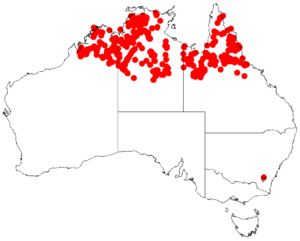Clubleaf wattle facts for kids
Quick facts for kids Clubleaf wattle |
|
|---|---|
 |
|
| Acacia hemignosta flowers | |
| Scientific classification | |
| Genus: |
Acacia
|
| Species: |
hemignosta
|
 |
|
| Occurrence data from AVH | |
Acacia hemignosta, also known as the clubleaf wattle, is a type of tree or shrub. It belongs to the Acacia family. This plant only grows naturally in northern Australia.
What the Clubleaf Wattle Looks Like
This tree or shrub usually grows between 1 and 7 meters (about 3 to 23 feet) tall. Sometimes, it can even reach 10 meters (about 33 feet)! Its bark is rough and looks like cork. The branches hang down and are easy to break.
Instead of typical leaves, this wattle has special leaf-like parts called phyllodes. They are green, yellowish-green, or grayish-green. Each phyllode is shaped like a narrow spear, about 6 to 15 centimeters long and 1 to 3 centimeters wide. They have three main veins.
The clubleaf wattle blooms from June to October. It produces bright yellow flowers. These flowers grow in round clusters, with each cluster having 30 to 50 golden flowers. After the flowers, flat, straight seed pods appear. These pods are about 8 centimeters long and 8 to 12 millimeters wide. Inside, the seeds are dull brown and oval-shaped, about 5.5 to 6.5 millimeters long.
Where the Clubleaf Wattle Grows
You can find the clubleaf wattle in the Northern Territory, the Kimberley region of Western Australia, and northern Queensland. It likes to grow in flat or gently rolling areas. You'll often see it in sandy or lateritic soils. It also grows in heavier soils near water, usually as part of open woodland areas.

